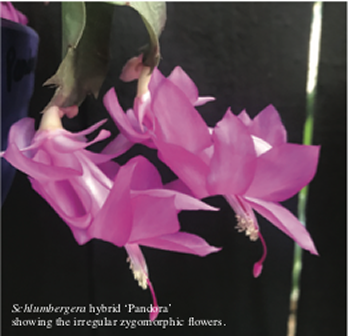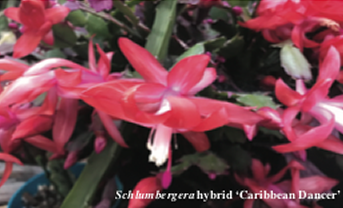How to Make a Christmas Cactus Bloom Again
By Gretchen Ward
(This article first appeared in the November/December 2021 issue of California Garden)
Did you get a “Christmas Cactus” last year to decorate your home? It probably looked lovely and lush, full of blooms just ready to burst forth with lots of holiday cheer. Since then you have kept it alive, and now the holidays are approaching again— but where are the blooms, where are the beautiful blossoms, what happened? Why isn’t my Christmas Cactus about to bloom again?
Identifying Cactus Types
The Christmas cactus is a Schlumbergera hybrid, also sometimes called a Holiday Cactus, or sometimes a Thanksgiving cactus. Schlumbergera is a small genus of epiphytic tropical cacti with nine species found in the coastal mountains of southeastern Brazil. Most species of Schlumbergera have stems that resemble segmented leaf-like pads with the flowers developing from areoles at the joints and tips of the stems.
 You may see tags on some of these plants in stores labeling them a Zygocactus—an old name for the Schlumbergera truncata group of hybrids with pointed and notched stem segments. Zygocactus is a descriptive name that refers to the zygomorphic flowers that some of the Schlumbergera species have. Zygomorphic flowers are flowers that are not regular— they are flat on one side. These pointy stemmed Schlumbergera originally came to us as Thanksgiving cactus. The old-fashioned Christmas cactus is part of the Buckleyi group of Schlumbergera hybrids, which has a smoother, rounded stem. And, as the names indicate, one is more prone to begin blooming in November with the other blooming towards the end of December.
You may see tags on some of these plants in stores labeling them a Zygocactus—an old name for the Schlumbergera truncata group of hybrids with pointed and notched stem segments. Zygocactus is a descriptive name that refers to the zygomorphic flowers that some of the Schlumbergera species have. Zygomorphic flowers are flowers that are not regular— they are flat on one side. These pointy stemmed Schlumbergera originally came to us as Thanksgiving cactus. The old-fashioned Christmas cactus is part of the Buckleyi group of Schlumbergera hybrids, which has a smoother, rounded stem. And, as the names indicate, one is more prone to begin blooming in November with the other blooming towards the end of December.
Hybrid Habits
 The best way to get a Schlumbergera hybrid to bloom is to provide it with the right conditions to thrive. Plant nurseries prepare the hybrids for blooming by keeping them in optimal conditions at perfect temperatures and with the proper light. These epiphytic cacti will develop blooms after experiencing a resting period and the longer periods of darkness that come on in the Autumn months. In most of Southern California, Schlumbergera hybrids can easily be grown outside year-round. Keep them in dappled sunlight and out of the direct noonday sun. As the summer progresses into the fall, we gardeners naturally cut back on watering when our evenings cool and the longer nights signal the plant that it is time to set buds. If you have kept your plant inside all year, it may not be cool enough or dark enough in your home to stimulate the flower bud growth.
The best way to get a Schlumbergera hybrid to bloom is to provide it with the right conditions to thrive. Plant nurseries prepare the hybrids for blooming by keeping them in optimal conditions at perfect temperatures and with the proper light. These epiphytic cacti will develop blooms after experiencing a resting period and the longer periods of darkness that come on in the Autumn months. In most of Southern California, Schlumbergera hybrids can easily be grown outside year-round. Keep them in dappled sunlight and out of the direct noonday sun. As the summer progresses into the fall, we gardeners naturally cut back on watering when our evenings cool and the longer nights signal the plant that it is time to set buds. If you have kept your plant inside all year, it may not be cool enough or dark enough in your home to stimulate the flower bud growth.
Quick Tips For Encouraging Blooms:
- Schlumbergera hybrids grow best in bright shade.
- Plants prefer a well-draining soil mixture.
- Give plants a bit more sunlight during fall and winter, but not direct noonday sun.
- Ideal spring and summer growth occurs at temperatures between 70–80 degrees F.
- Continuous warm temperatures can cause buds to drop, especially above 90 degrees F.
- Blooms benefit from shorter days and longer cooler nights to encourage bud set.
- Pinch back stems after blooming to promote branching and more terminals in order to stimulate more flowers for the next bloom cycle.
- Avoid freezing temperatures; plants will die if left out in a hard freeze.
- Encourage crowded, mature roots to promote blooms.
- Apply low-nitrogen fertilizer before blooming season starts.
Gretchen Ward has been a UCCE Master Gardener since 2020

